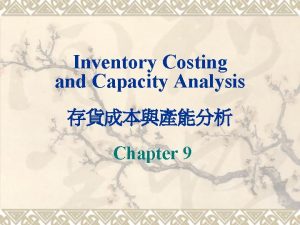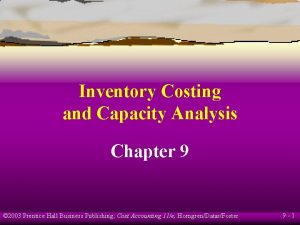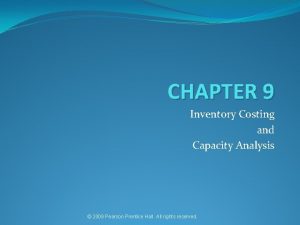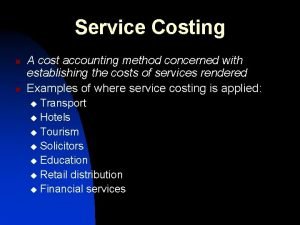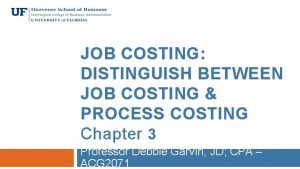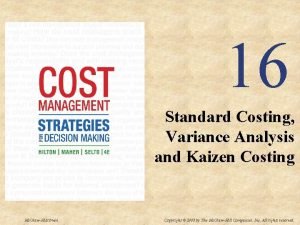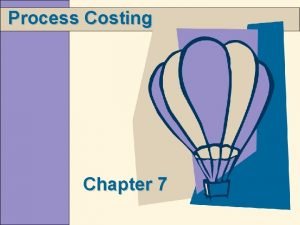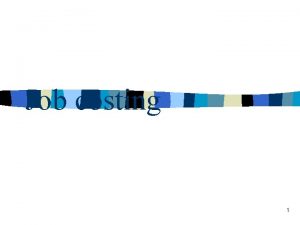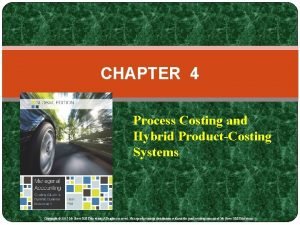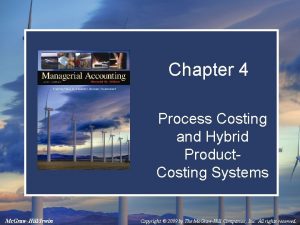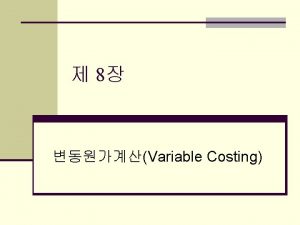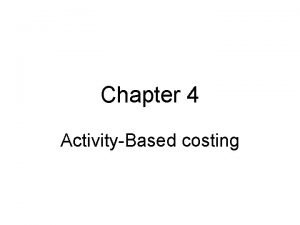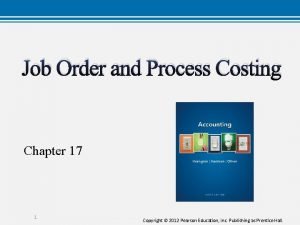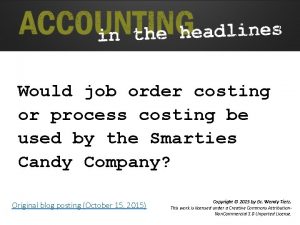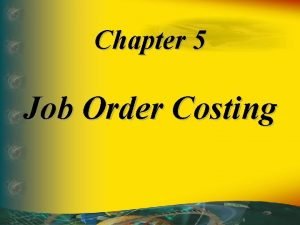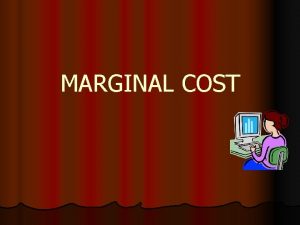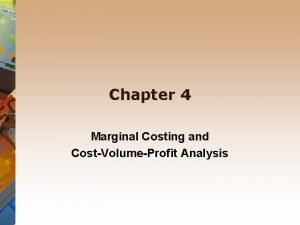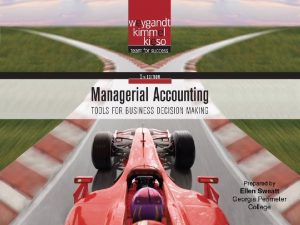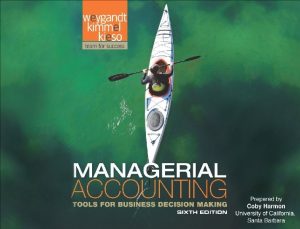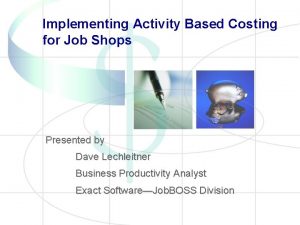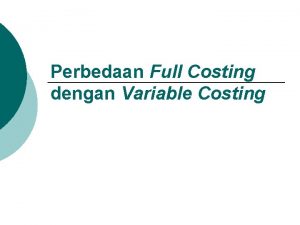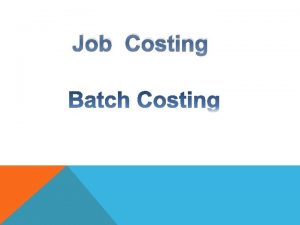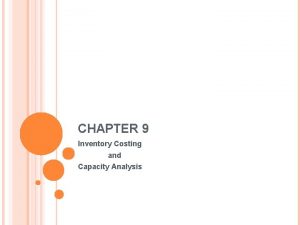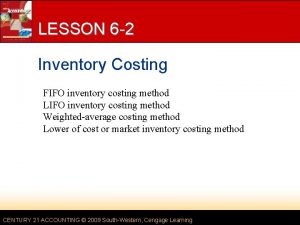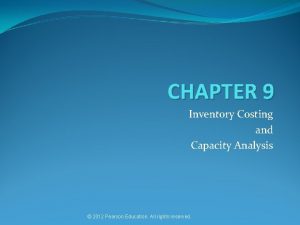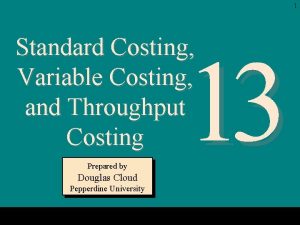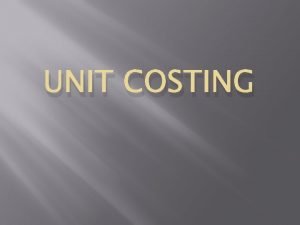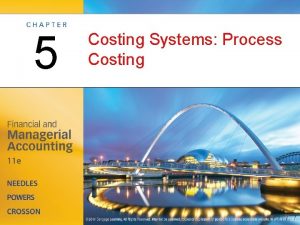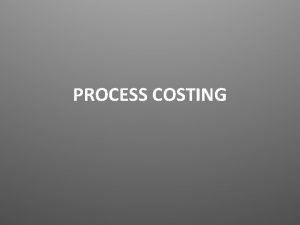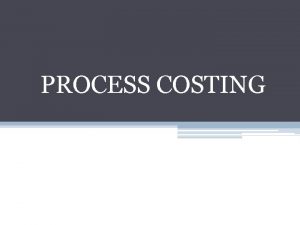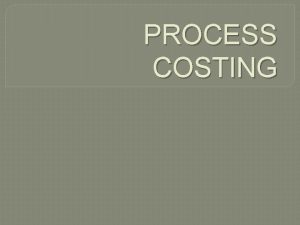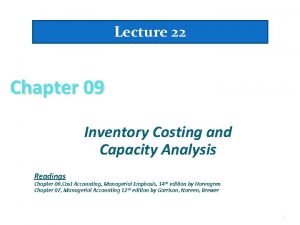Chapter 9 Inventory Costing and Capacity Analysis 2009


























- Slides: 26

Chapter 9 Inventory Costing and Capacity Analysis 2009 Foster School of Business Cost Accounting L. Du. Charme 1

Overview—Chapter 9 • • • Inventory Costing Methods Denominator Issues Example: working backwards BEPs: VC versus AC Solution to extra problem (on webpage) 2009 Foster School of Business Cost Accounting L. Du. Charme 2

Absorption Costing • All manufacturing cost are considered inventoriable: – – • • All variable mfg. costs (both direct & indirect) All fixed mfg. costs (both direct & indirect) Separates costs by business function. Other costing terms: (1) Super-full absorption costing: includes some mfg. related admin costs—used for tax. (2) Full-product costing: costs from all areas of value chain are attached to product costs—for L-T pricing. 2009 Foster School of Business Cost Accounting L. Du. Charme 3

Variable Costing • All variable manufacturing costs are considered inventoriable. • Separates costs by cost behavior. • Some managers call this direct costing which is a poor choice of name. Why? 2009 Foster School of Business Cost Accounting L. Du. Charme 4

Throughput Costing • Also called super-variable costing. • Only variable direct materials are inventoriable. Assumes that only DM are variable in the short run. • Reduces incentives to build up inventories. • Relatively new and not widely used. 2009 Foster School of Business Cost Accounting L. Du. Charme 5

STOP! The big picture • Managers make a number of accounting choices that affect income, for example: Costing Systems Fixed Mfg. Costs Flow of Costs Actual AC Job FIFO Normal VC Process LIFO Standard Tput Avg. Other Specific I. D. Standard Retail 2009 Foster School of Business Cost Accounting L. Du. Charme 6

Inventory-Costing Methods The difference between variable costing and absorption costing is based on the treatment of fixed manufacturing costs. AC includes fixed mfg. costs in cost of inventory, while VC does not. VC expenses all fixed costs as period costs. 2009 Foster School of Business Cost Accounting L. Du. Charme 7

Comparing Income Statements: Absorption vs. Variable Costing The following data pertain to Davenport Pencils: Produce one product: #2 pencils. 1 box = 1 gross. Sales price = $8/box; Sold 40, 000 boxes DM = $3 / box; DL = $0. 50 / box VMOH = $0. 25 / box FMOH = $100, 000 / year Sales commission = $0. 75 / box Fixed admin. expenses = $30, 000 / year Budget = actual production = 50, 000 boxes 2009 Foster School of Business Cost Accounting L. Du. Charme 8

Comparing Income Statements What is the cost per box under VC? $3. 00 + 0. 50 + 0. 25 = $3. 75 What is the cost per box under AC? $3. 00 + 0. 50 + 0. 25 + 2. 00* = $5. 75 * Fixed mfg. OH rate = $2. 00 / box = $100, 000 / 50, 000 boxes 2009 Foster School of Business Cost Accounting L. Du. Charme 9

Comparing Income Statements Absorption Costing Variable Costing Revenue $320, 000 Co. GS 230, 000 GM 90, 000 S&A 60, 000 Op. Inc. $ 30, 000 Revenue VC CM FC Op. Inc. 2009 Foster School of Business Cost Accounting L. Du. Charme $320, 000 180, 000 140, 000 130, 000 $ 10, 000 10

Comparison of Variable and Absorption Costing Variable costing operating income : $10, 000 Absorption costing operating income : $30, 000 Absorption costing operating income is $20, 000 higher. Why? 2009 Foster School of Business Cost Accounting L. Du. Charme 11

Comparison of Variable and Absorption Costing Production exceeds sales. The 10, 000 unit increase in ending inventory are valued as follows: Absorption costing: 10, 000 × $5. 75 = $ 57, 500 Variable costing: 10, 000 × $3. 75 = $ 37, 500 Difference: 2009 Foster School of Business $ 20, 000 Cost Accounting L. Du. Charme 12

Comparison of Variable and Absorption Costing COGS Absorption costing: 40, 000 X $5. 75 = $230, 000 Variable costing: 40, 000 X $3. 75 = $150, 000 Plus all the fixed mfg. OH = $100, 000 Lower costs recognized under absorption costing: 2009 Foster School of Business Cost Accounting L. Du. Charme $ 20, 000 13

Comparison of Variable and Absorption Costing Under absorption costing, each of the additional 10, 000 boxes in ending inventory is storing $2/box cost that will be expensed later when sold. 10, 000 units of inventory × $2. 00 = $20, 000 2009 Foster School of Business Cost Accounting L. Du. Charme 14

Comparison of Variable and Absorption Costing Absorption costing operating income Variable costing operating income – EQUALS Fixed manufacturing costs in ending inventory under absorption costing 2009 Foster School of Business Cost Accounting – L. Du. Charme Fixed manufacturing costs in beginning inventory under absorption costing 15

Absorption Costing & Inventory Buildup What happens over the long run? How might you mitigate the incentive to build up inventory? 2009 Foster School of Business Cost Accounting L. Du. Charme 16

Alternative Denominator-Level Concepts Theoretical capacity Practical capacity Normal capacity Master-budget capacity 2009 Foster School of Business Cost Accounting L. Du. Charme 17

Budgeted Fixed Manufacturing Overhead Rate Lloyd’s Bicycles produces bicycle parts for domestic and foreign markets. Fixed overhead costs are $200, 000 within the relevant range of the various capacity volume. 2009 Foster School of Business Cost Accounting L. Du. Charme 18

Budgeted Fixed Manufacturing Overhead Rate Assume that theoretical capacity is 10, 000 machine-hours, practical capacity is 85%, normal capacity is 75%, and master-budget capacity is 60%. What is the budgeted fixed manufacturing overhead rate at the various capacity levels? 2009 Foster School of Business Cost Accounting L. Du. Charme 19

Budgeted Fixed Manufacturing Overhead Rate Theoretical 100%: $200, 000 ÷ 10, 000 = $20. 00/machine-hour Practical 85%: $200, 000 ÷ 8, 500 = $23. 53/machine-hour Normal 75%: $200, 000 ÷ 7, 500 = $26. 67/machine-hour Master-budget 60%: $200, 000 ÷ 6, 000 = $33. 33/machine-hour 2009 Foster School of Business Cost Accounting L. Du. Charme 20

Effect of Denominator Level Choice • The larger the denominator level, the: – Lower the budgeted FM rate. – Lower Fixed Mfg. costs in E. Inv. – Higher the unfavorable PVV for fixed OH Remember—Fixed mfg. are either expensed in the period or stored in E. Inv. What denominator level would you want to use for tax purposes? [practical is required for tax] 2009 Foster School of Business Cost Accounting L. Du. Charme 21

Decision Making Assume that Lloyd’s Bicycles’ standard hours are 2 hours per unit. What is the budgeted fixed manufacturing overhead cost per unit? 2009 Foster School of Business Cost Accounting L. Du. Charme 22

Decision Making Theoretical capacity: $20 × 2 = $40. 00 Practical capacity: $23. 53 × 2 = $47. 06 Normal capacity: $26. 67 × 2 = $53. 34 Master-budget capacity: $33. 33 × 2 = $66. 66 2009 Foster School of Business Cost Accounting L. Du. Charme 23

Exercise—working backward QQQ Company has op. income of $120, 000 under absorption costing, and op. income would be $100, 000 under variable costing. FMOH = $500, 000 Budgeted and actual production = 200, 000 units. Did inventory increase or decrease during the period? By how much? 2009 Foster School of Business Cost Accounting L. Du. Charme 24

In-class problem • Answer depends on the FMOH rate for B. Inv and choice of inventory cost-flow method (FIFO, WA, LIFO, etc. ). • Assume no change in FMOH rate. Then choice of cost-flow method does not matter. • FMOH rate = $500 k / 200 k = $2. 50 / unit 2009 Foster School of Business Cost Accounting L. Du. Charme 25

Calculation of BE points • Unique solution under Variable Costing: Ø BEPvc = Total FC / UCM • Solution depends on production level under Absorption Costing: Ø BEPac = [Total FC + (FM rate* (BEPac – Units Produced))] / UCM Ø BEPac = [Total FC – (FMR*UP)] / (UCM – FMR) What happens to the BEP when more units are produced? 2009 Foster School of Business Cost Accounting L. Du. Charme 26
 Inventory costing and capacity analysis
Inventory costing and capacity analysis Chapter 9 inventory costing and capacity analysis
Chapter 9 inventory costing and capacity analysis Inventory costing and capacity analysis
Inventory costing and capacity analysis Difference between service costing and product costing
Difference between service costing and product costing Difference between job costing and process costing
Difference between job costing and process costing Difference between job costing and contract costing
Difference between job costing and contract costing General model for variance analysis
General model for variance analysis Both job order costing and process costing
Both job order costing and process costing Process costing and hybrid product-costing systems
Process costing and hybrid product-costing systems Process costing and hybrid product-costing systems
Process costing and hybrid product-costing systems Hybrid costing system
Hybrid costing system Hybrid costing system
Hybrid costing system Job costing vs. process costing
Job costing vs. process costing Marginal costing and absorption costing
Marginal costing and absorption costing Chapter 4 activity-based costing solutions
Chapter 4 activity-based costing solutions Example of cost sheet
Example of cost sheet Job costing vs process costing
Job costing vs process costing Job order costing vs process costing
Job order costing vs process costing Job order cost
Job order cost Marginal costing meaning
Marginal costing meaning Variable costing vs absorption costing
Variable costing vs absorption costing Cvp assumptions
Cvp assumptions Activity based costing formula
Activity based costing formula Advantages of activity based costing
Advantages of activity based costing Activity based costing vs job costing
Activity based costing vs job costing Perbedaan full costing dan variable costing
Perbedaan full costing dan variable costing Job costing vs batch costing
Job costing vs batch costing
